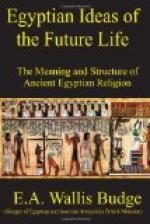4. Nebseni addressing a bearded mummied figure.
5. Three Pools or Lakes called Urti, Hetep, and Qetqet.
6. Nebseni reaping in Sekhet-hetepet.
7. Nebseni grasping the Bennu bird,
which is perched upon a stand; in
front are three KAU and three KHU.
8. Nebseni seated and smelling a
flower; the text reads: “Thousands of
all good and pure things to the KA of
Nebseni.”
9. A table of offerings.
10. Four Pools or Lakes called Nebt-tani, Uakha, Kha(?), and Hetep.
11. Nebseni ploughing with oxen by
the side of a stream which is one
thousand [measures] in length, and the
width of which cannot be said;
in it there are neither fish nor worms.
12. Nebseni ploughing with oxen on
an island “the length of which is
the length of heaven.”
13. A division shaped like a bowl,
in which is inscribed: “The
birthplace(?) of the god of the city Qenqentet
Nebt.”
14. An island whereon are four gods
and a flight of steps; the legend
reads: “The great company of
the gods who are in Sekhet-hetep.”
15. The boat Tchetetfet, with eight
oars, four at the bows, and four
at the stern, floating at the end of a
canal; in it is a flight of
steps. The place where it lies is
called the “Domain of Neth.”
16. Two Pools, the names of which
are illegible. The scene as given in
the Papyrus of Ani [Footnote: Brit.
Mus., No. 10,470, Plate 35] gives
some interesting variants and may be described
thus:—
1. Ani making an offering before a hare-headed god, a snake-headed god, and a bull-headed god; behind him stand his wife Thuthu and Thoth holding his reed and palette. Ani paddling a boat. Ani addressing a hawk, before which are a table of offerings, a statue, three ovals, and the legend, “Being at peace in the Field, and having air for the nostrils.”
2. Ani reaping corn, Ani driving the oxen which tread out the corn; Ani addressing (or adoring) a Bennu bird perched on a stand; Ani seated holding the kherp sceptre; a heap of red and a heap of white corn; three KAU and three KHU, which are perhaps to be read, “the food of the spirits;” and three Pools.
3. Ani ploughing a field near a stream which contains [Illustration: The Elysian Fields of the Egyptians according to the Papyrus of Ani (XVIIIth dynasty).] neither fish, nor serpents, nor worms of any kind whatsoever.
4. The birthplace of the “god of the city;” an island on which is a flight of steps; a region called the “place of the spirits” who are seven cubits high, where the wheat is three cubits high, and where the S[=A]HU, or spiritual bodies, reap it; the region Ashet, the god who dwelleth therein being Un-nefer (i.e., a form of Osiris); a boat with eight oars lying at the




